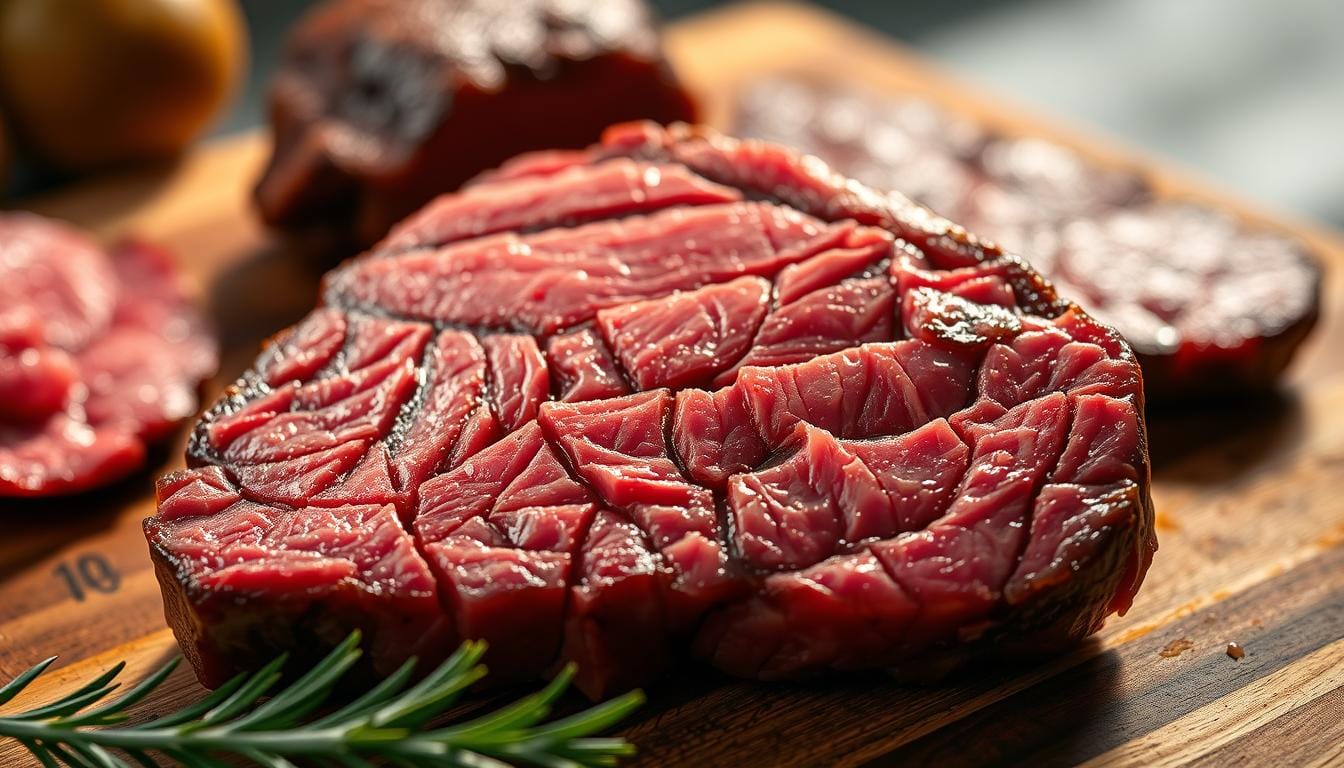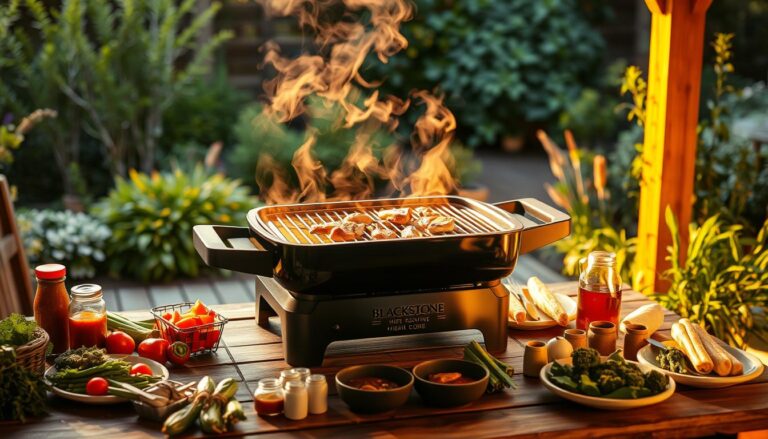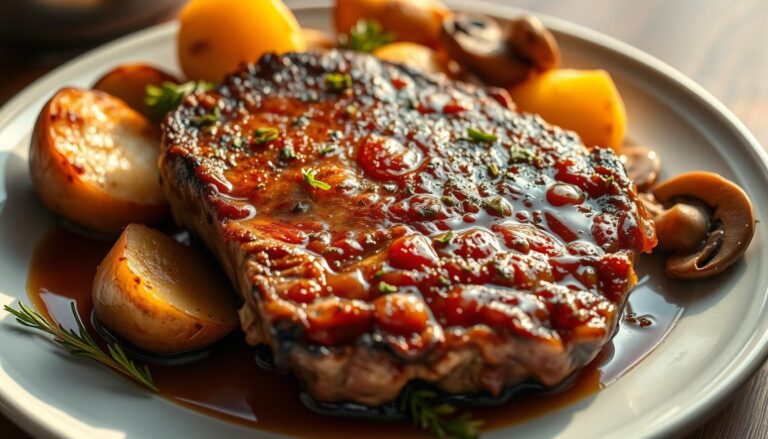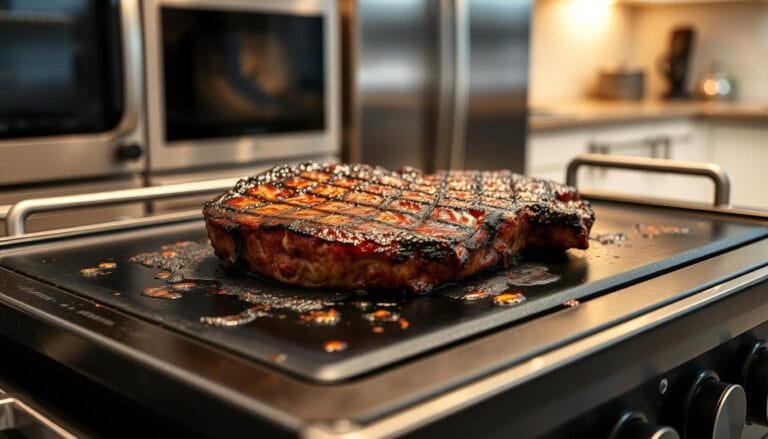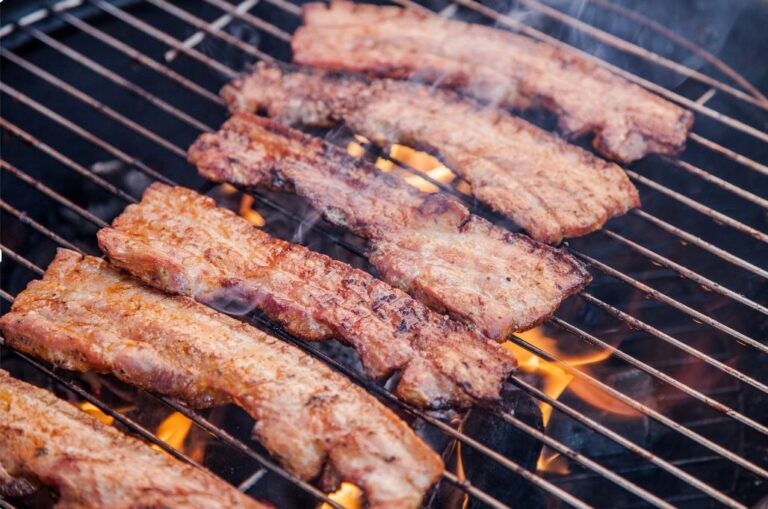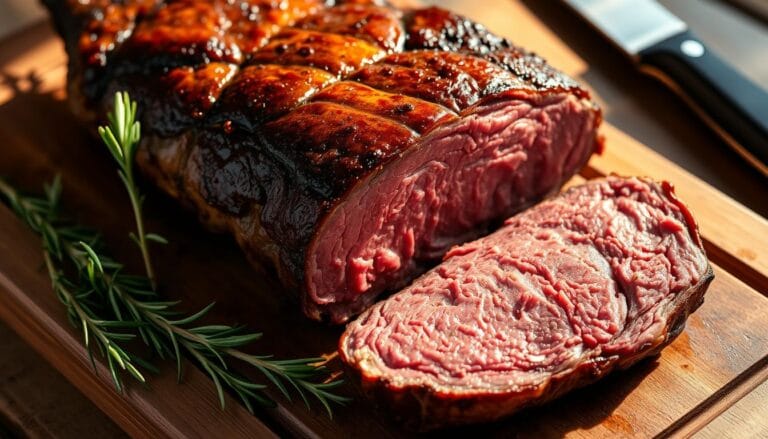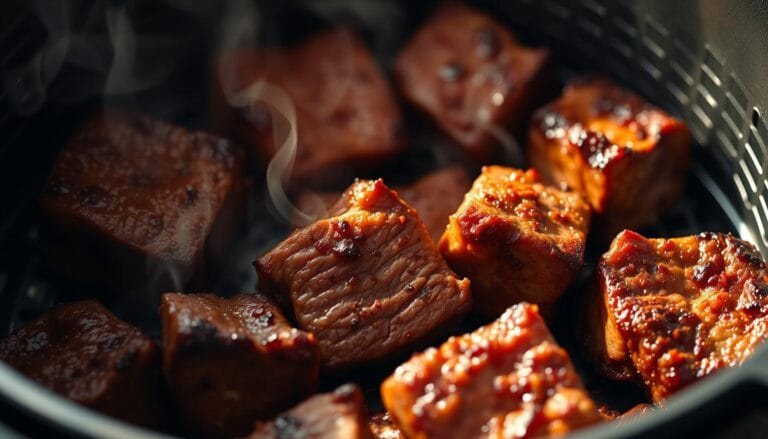Picanha Steaks: The Brazilian Cut That’ll Blow Your Mind
Table of Contents
Picanha Steaks: The Brazilian Cut That’ll Blow Your Mind
Imagine biting into a tender, juicy piece of beef. It has a rich, beefy taste and a crispy, golden-brown crust. This is what picanha steaks offer, a culinary delight that’s taken the world by storm.
This cut of beef comes from Brazilian cuisine. It’s famous for its fat cap, which adds flavor and keeps the meat juicy. In Brazil, this cut is a big deal, often the star of gatherings and celebrations.
Exploring picanha reveals why it’s loved by meat lovers worldwide. Its unique qualities make it a standout, whether at backyard barbecues or fancy restaurants.
Key Takeaways
- Discover the unique characteristics of picanha that set it apart from other beef cuts.
- Learn about the cultural significance of picanha in Brazilian cuisine.
- Understand the role of the fat cap in making picanha flavorful and juicy.
- Explore ways to add picanha to your cooking.
- Find out why picanha is becoming a favorite globally among food lovers.
What Are Picanha Steaks?
Picanha steaks are a hit among food lovers, but what are they? They come from Brazilian churrasco traditions. This cut is famous in Brazil and loved worldwide for its taste and softness.
The Origins of Picanha
Picanha comes from the top sirloin cap of the cow. It’s known for its rich taste and soft texture. In Brazil, it’s a key part of churrasco, a traditional barbecue.
“Picanha is more than just a cut of meat; it’s an experience,” say chefs who know Brazilian food. Cooking Picanha is a tradition passed down through generations, with each adding their own twist.
Characteristics That Make It Special
So, what makes Picanha steaks special? They have a triangular shape, a fat cap, and are very tender. The fat cap adds to the flavor and tenderness, making it a favorite among steak lovers.
- The top sirloin cap location gives Picanha its distinct taste and texture.
- The triangular shape and signature fat cap are hallmarks of this cut.
- The muscle structure ensures a tender eating experience.
Knowing these traits helps you see why Picanha steaks are a delicacy. They can make your meals even better.
The Flavors of Picanha
Picanha steaks are known for their unique taste. They have a strong beef flavor mixed with a buttery richness. This taste comes from the cut’s characteristics and how it’s cooked.
Unique Taste Profile
Picanha steaks have a rich flavor profile. This is because of where they come from on the cow and their makeup. The fat cap adds tenderness and boosts the flavor, making it a satisfying dish.
The fat cap on picanha steaks is special. It melts when cooked, adding a buttery richness to the meat. This, along with the meat’s natural tenderness, makes picanha a favorite among beef lovers.
Cooking Methods to Highlight Flavor
Cooking picanha steaks right is key to bringing out their flavors. Grilling is a favorite because it gives a nice char on the outside. This enhances the robust beef flavor while keeping the inside juicy.
Other ways like roasting or pan-searing also work well. The goal is to melt the fat cap slowly. This keeps the meat tender and full of flavor. Trying different cooking methods can help you find your favorite way to enjoy picanha.
Choosing the Right Picanha
Finding the perfect picanha starts with picking a top-notch cut. At the butcher or supermarket, knowing what to look for is key. It makes all the difference in your cooking.
What to Look for in Quality
Quality picanha has a few important features. The fat cap should be white and evenly distributed, about 1/4 to 1/2 inch thick. This fat cap is vital as it melts, adding rich flavors to the meat.
The meat should have a good color and marbling, showing it’s tender and flavorful. It’s also important that the meat smells fresh and doesn’t have a strong or slimy texture.
In the U.S., picanha might be called “top sirloin cap” or “culotte.” Knowing these names helps you find real picanha. If unsure, ask your butcher about the cut and where it comes from.
Cuts and Thickness Preferences
Picanha comes in different thicknesses, depending on what you like and how you cook. Brazilians often choose thicker cuts for a nice char and juicy inside. These are perfect for slow cooking or grilling, ensuring the meat stays juicy.
For those who prefer quicker cooking, thinner steaks might be better. But, they need careful cooking to avoid drying out. Thinner cuts are best for pan-searing or high-heat grilling, where a quick sear keeps the juices in.
- Thicker cuts (1-1.5 inches) are great for grilling and slow cooking.
- Thinner cuts (about 0.5-1 inch) are ideal for pan-searing.
Knowing these differences helps you choose the right picanha for your cooking. It ensures a delicious meal.
Cooking Picanha Steaks
Picanha steaks are known for their rich flavor and tender texture. They can be cooked in several ways to enhance their natural flavors. Understanding the different techniques is key to cooking picanha steaks perfectly.
Best Cooking Techniques
There are several ways to cook picanha steaks, each with its own unique flavor. The traditional Brazilian rotisserie method is a favorite, as it cooks the steak evenly. You can also use direct and indirect grilling for a nice sear and juicy inside. Pan-searing adds a crispy crust, while oven roasting offers controlled cooking.
When choosing a cooking method, think about your equipment and desired flavor. Grilling gives a smoky taste, while pan-searing creates a rich, caramelized crust.
Grilling vs. Roasting: Pros and Cons
Grilling and roasting are both great for cooking picanha steaks. Grilling gives a beautiful sear and a smoky flavor that many love. But, it needs constant attention to avoid overcooking. Roasting, on the other hand, offers consistent temperature control for even cooking. It’s perfect for larger cuts or when cooking for many.
- Grilling: Pros – smoky flavor, beautiful sear; Cons – requires constant monitoring, risk of overcooking.
- Roasting: Pros – consistent temperature control, even cooking; Cons – may lack the smoky flavor of grilling.
Time and Temperature Guidelines
To cook picanha steaks to your liking, follow specific time and temperature guidelines. For rare, aim for 130°F – 135°F. For medium-rare, 135°F – 140°F. For medium, 140°F – 145°F. The cooking time depends on the steak’s thickness and the method. A 1-inch thick steak cooked in a preheated oven at 400°F may take 8-12 minutes to reach medium-rare.
| Doneness | Internal Temperature | Cooking Time (approx.) |
|---|---|---|
| Rare | 130°F – 135°F | 6-8 minutes |
| Medium-Rare | 135°F – 140°F | 8-12 minutes |
| Medium | 140°F – 145°F | 12-15 minutes |
Using a meat thermometer is the most accurate way to ensure your picanha steak is cooked to your liking.
Seasoning Picanha Steaks
Seasoning Picanha Steaks right can change your dining experience. It’s not just about adding flavor. It’s about bringing out the meat’s natural taste.
Traditional Brazilian Seasoning
In Brazil, Picanha is seasoned with coarse salt. This highlights the meat’s simplicity and quality. A lot of salt is used to let it soak into the meat, boosting its flavor.
To season your Picanha Steaks like a Brazilian:
- Use coarse salt, preferably kosher or sea salt.
- Apply the salt liberally to the fat cap and the meat.
- Let it sit for about 30 minutes before cooking to allow the salt to penetrate.
Creative Marinade Ideas
Want to try something new? There are many marinades that can enhance Picanha’s rich taste. Here are a few ideas:
- A garlic and herb marinade, combining minced garlic with fresh herbs like parsley and thyme.
- A chimichurri-inspired marinade, featuring parsley, oregano, garlic, and a squeeze of fresh lime juice.
- A citrus and spice marinade, mixing orange or lemon juice with spices like cumin and paprika.
Trying different marinades can give your Picanha Steaks a unique flavor. It makes every dish a new culinary adventure.
Slicing Picanha Correctly
To enjoy picanha fully, slicing it right is key. It makes the meat tender and flavorful. Knowing how to slice picanha is vital for a great dining experience.
Importance of Slicing Against the Grain
Slicing against the grain is essential for picanha steaks. The grain is the muscle fiber direction. Slicing against the grain cuts these fibers short, making the meat tender. To find the grain, look for lines on the meat’s surface.
How to Achieve Perfect Slices
For perfect picanha slices, follow a few steps. First, use a sharp, thin-bladed knife for clean cuts. Slice the picanha to 1/2 to 3/4 inch thick, as is traditional in Brazil.
| Slicing Technique | Ideal Thickness | Knife Recommendation |
|---|---|---|
| Against the Grain | 1/2 to 3/4 inch | Sharp, thin-bladed knife |
| Perpendicular cut | Consistent thickness | High-carbon stainless steel |
When slicing, use a smooth motion and gentle pressure. Slice the meat when it’s slightly cooled. This makes it easier to slice than hot or cold meat. By doing this, you’ll get tender and flavorful picanha slices.
Pairing Picanha with Sides
Pairing the right sides with picanha steaks can make your meal even better. Picanha steaks have a rich flavor that can be enhanced by different sides and drinks. The goal is to find the perfect balance that doesn’t overshadow the picanha.
Popular Side Dishes for Picanha
Picanha steaks go well with both traditional Brazilian dishes and modern American favorites.
- Try farofa (toasted cassava flour), vinagrete (Brazilian vinaigrette), rice, and beans for a traditional taste.
- For something new, roasted vegetables, chimichurri potatoes, and grilled corn are great options.
Wine and Beverage Pairing Tips
Choosing the right wine or drink can balance the bold taste of picanha steaks.
- Red wine lovers should try Malbec or Cabernet Sauvignon.
- Beer fans might enjoy a craft IPA or a classic Brahma from Brazil.
- For those who don’t drink alcohol, lime and mint infused water or Brazilian lemonade are refreshing choices.
Picanha in Brazilian Culture
Picanha in Brazil is more than just a tasty dish. It’s a symbol of tradition and unity. Picanha steaks are key to Brazilian identity, loved at social events and celebrations.
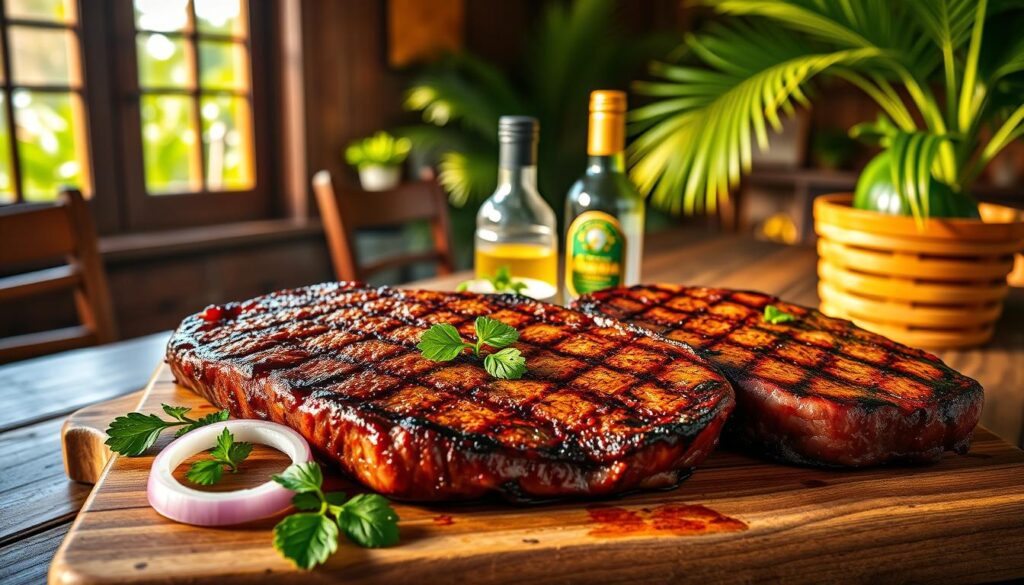
The Role of Picanha in Churrasco
Churrasco, Brazil’s traditional barbecue, highlights picanha. In churrascarias, picanha is served on skewers with flair. This makes dining a show, not just a meal.
The churrasco tradition comes from Southern Brazil’s cowboy culture. It evolved into today’s sophisticated dining, with picanha as a highlight.
| Aspect | Description | Significance |
|---|---|---|
| Presentation | Serving on skewers | Theatrical and engaging dining experience |
| Origin | Gaucho culture in Southern Brazil | Roots in traditional cowboy cuisine |
| Cultural Impact | Central to churrasco and celebrations | Symbolizes community and festivity |
Celebrating with Picanha
In Brazil, picanha is more than food; it’s a way to unite people. It’s at the heart of family gatherings, special events, and holidays. Sharing picanha is a social ritual that brings people closer.
Picanha’s high status in Brazilian cuisine makes it perfect for celebrations. Adding picanha to your events can bring a piece of Brazilian culture to your guests, making memories that last.
Nutritional Profile of Picanha
Picanha is not just tasty; it’s also packed with nutrients. It’s a great choice for those looking to eat well. Picanha steaks can add health benefits to your diet.
Health Benefits of Eating Picanha
Picanha is full of protein, which is key for muscle health. It also has important amino acids, vitamins, and minerals. The B vitamins in picanha, like B12 and B6, help with energy and brain function.
It’s also rich in iron, zinc, and phosphorus. These minerals are good for blood, immune health, and bones.
Dr. Marion Nestle, a top nutrition expert, said, “Meat can be good for you if you choose and cook it wisely.”
“The nutritional benefits of meat, including picanha, lie in its high-quality protein and micronutrients.”
Understanding Fat Content
The fat cap on picanha steaks makes them taste great and feel tender. But, it’s important to know what kind of fat it is. Picanha has both saturated and unsaturated fats.
Saturated fats can raise cholesterol levels. But, they also give energy and help with vitamin absorption. The trick is to eat them in moderation.
To keep your diet balanced, you can trim some fat from picanha. Or, try grilling it. This method can make the steak tender and tasty while reducing fat.
Storage Tips for Picanha
Proper storage of picanha steaks is key to a great meal. Whether it’s raw or cooked, how you store it affects its quality.
How to Properly Store Picanha
Raw picanha needs cold storage. Keep it in the fridge’s coldest spot, below 40°F (4°C). Use its original packaging or wrap it tightly in plastic or foil to prevent oxidation.
If you won’t cook it soon, freeze it. Wrap it well in freezer-safe packaging, removing air before sealing. Frozen picanha lasts for months.
Cooked picanha should cool to room temperature before refrigeration. Use airtight containers to keep moisture and flavors out. For longer storage, freeze it. Slice it, wrap each piece tightly, and store in freezer-safe bags.
Safeguarding Freshness and Flavor
Protect the fat cap of picanha to prevent rancidity. Store it away from strong-smelling foods to avoid absorbing odors. When reheating, use gentle heat to keep it moist.
Chef Alex Atala said, “Meat quality isn’t just about breed or cut. It’s also about how you treat it.” Proper storage is key to preserving picanha’s flavor and texture.
By storing picanha correctly, you keep it fresh and flavorful. It’s ready to be enjoyed at its best.
Common Mistakes When Cooking Picanha
Learning what not to do is key to a delicious picanha. Cooking this Brazilian favorite is easy if you know the common mistakes. These mistakes can make your dish less than perfect.
Missteps to Avoid
Several mistakes can ruin your picanha. One big error is removing the fat cap before cooking. This fat cap keeps the meat moist and adds flavor. Also, don’t cook picanha straight from the fridge without letting it warm up to room temperature.
Using the wrong heat is another mistake. Picanha needs high heat for a nice crust but watch it to avoid burning. Overcooking is common, as picanha can quickly become tough and dry. It’s important to cook it right and then let it rest.
Seasoning at the wrong time can also affect flavor. Seasoning too early or too late can make the dish less tasty. Slicing the picanha against the grain is also important to avoid toughness.
Troubleshooting Tips for Perfect Results
Even with the best plans, things can go wrong. If your picanha is tough, it might be overcooked or not sliced right. For a charred exterior, try using lower heat towards the end. If it’s undercooked, adjust cooking time or use a thermometer.
For bland flavor, check your seasoning. Seasoning at the right time and using enough can improve taste. If it’s chewy, it might be overcooked or not rested before slicing.
| Common Issue | Troubleshooting Tip |
|---|---|
| Tough Picanha | Slice against the grain, avoid overcooking |
| Overly Charred Exterior | Adjust heat level, finish cooking at lower heat |
| Undercooked Interior | Use a thermometer, adjust cooking time |
| Bland Flavor | Revisit seasoning strategy, season generously |
| Excessively Chewy Texture | Avoid overcooking, let the meat rest |
Knowing common mistakes and having tips can help you cook great picanha. Whether you’re experienced or new to cooking, mastering picanha can make your meals better.
Picanha Recipes to Try
There are many ways to cook picanha, from traditional Brazilian methods to new twists. You can stick to the classics or try something new. This section will show you some tasty picanha recipes.
Classic Picanha Recipe
The classic Brazilian picanha recipe is loved for its simplicity. It lets the meat’s natural flavors shine. To make this dish, you’ll need:
- 1 picanha steak (about 1.5 to 2 pounds)
- Coarse salt (preferably kosher or sea salt)
Start by seasoning the picanha with coarse salt. Make sure to cover all sides. Let it sit at room temperature for 30 minutes. Then, grill it over medium-high heat until it’s cooked to your liking. Let it rest before slicing.
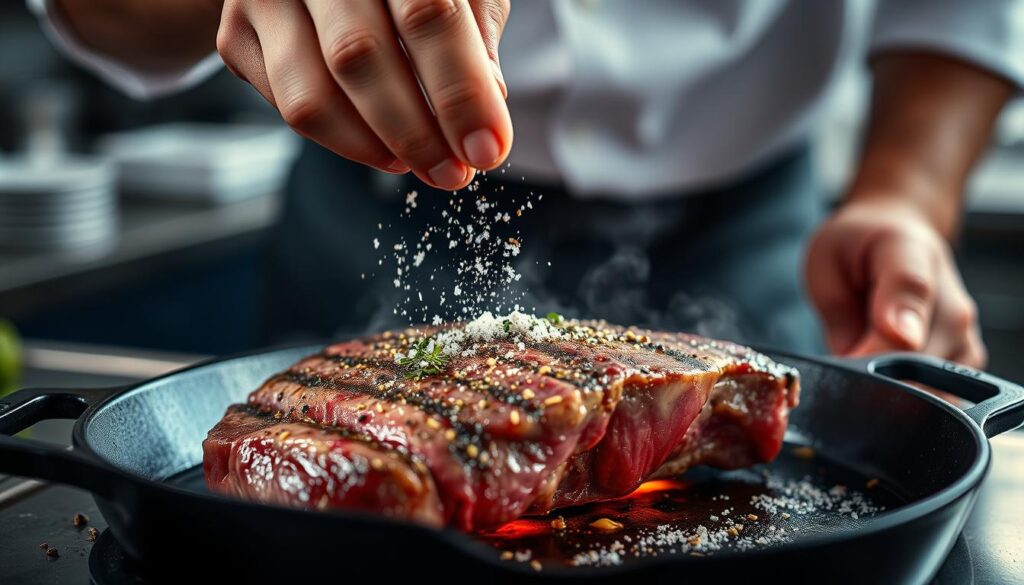
Innovative Variations
Want to try something new? There are many innovative picanha recipes out there. They add different flavors and cooking methods to the traditional picanha.
- Coffee-Rubbed Picanha: Mix ground coffee, brown sugar, smoked paprika, and cayenne pepper. Rub this on the picanha before grilling or roasting for a unique flavor.
- Herb-Crusted Picanha Roast: Blend parsley, rosemary, thyme, garlic, lemon zest, and olive oil. Coat the picanha with this mixture and roast until it’s cooked to your liking.
- Sous Vide Picanha with Searing Finish: Season the picanha with salt and aromatics. Seal it in a sous vide bag. Cook at 130°F to 135°F for 1 to 2 hours. Then, sear it in a hot pan for a crispy crust.
- Picanha with Chimichurri Butter: Mix softened butter with chimichurri sauce ingredients. Rub this under the fat cap of the picanha before grilling or roasting.
- Picanha Kebabs: Cut picanha into small pieces and marinate in olive oil, lime juice, garlic, and spices. Thread onto skewers and grill until cooked through. Serve with your favorite dipping sauce.
These recipes offer a variety of flavors and techniques. They range from simple twists to more advanced methods. Try these variations to find your new favorite picanha recipe.
Buying Picanha Steaks in the US
Picanha steaks are not common in US supermarkets. But, you can find them in specialty stores and online. Look for stores that specialize in Brazilian or Latin American products for the best quality.
Where to Find Quality Cuts
To find quality picanha steaks, check out specialty butcher shops. They often carry Brazilian cuts. Ethnic markets for South American communities also have them. Some high-end grocery stores might have picanha, labeled as “top sirloin cap” or “culotte steak.”
When shopping, tell your butcher it’s from the rump area. It’s known for its rich flavor and tender texture.
Online vs. Local Butchers
Choosing where to buy picanha depends on what you prefer. Online retailers offer convenience and a wide selection. They ship nationwide. Look for sellers with good reviews and detailed product info.
Local butchers provide personalized service and the chance to build a relationship. They ensure you get the best cuts. Ask about the meat’s origin and quality.
Using both online and local sources can give you the best experience. This way, you can find high-quality picanha steaks.
Exploring Regional Variations of Picanha
Picanha steaks are loved worldwide, with each place adding its own twist. This Brazilian cut has become a global favorite. Different regions have made it their own, creating unique flavors and cooking methods.
Different Cultural Takes on Picanha
Many cultures have adopted picanha, each with their own way of preparing it. In Argentina, it’s called “tapa de cuadril” and is grilled with chimichurri sauce. In Portugal, picanha is often roasted on skewers, seasoned with local herbs.
In Japan, picanha is thinly sliced for yakiniku, grilled at the table. Korea has its own version, marinated in a sweet and spicy sauce before grilling.
| Culture | Picanha Preparation Method | Signature Seasoning |
|---|---|---|
| Brazil | Grilled over open flame | Salt, garlic, and local herbs |
| Argentina | Grilled, served with chimichurri | Parsley, oregano, garlic, and red pepper |
| Portugal | Roasted on skewers | Olive oil, garlic, and paprika |
| Japan | Thinly sliced for yakiniku | Soy sauce, sake, and mirin |
| Korea | Marinated and grilled (bulgogi style) | Soy sauce, sugar, garlic, and sesame oil |
Unique Cooking Styles Worldwide
The world is seeing new ways to cook picanha. In the Mediterranean, it’s seasoned with herbs like thyme and rosemary. In America, it’s used in steak sandwiches and tacos.
A Mediterranean picanha might be marinated in olive oil and herbs before grilling. An American picanha taco could have grilled picanha, salsa, and avocado in a taco shell.
These variations show how picanha steaks are enjoyed globally. Whether grilled Brazilian-style or in a local dish, picanha offers a unique culinary experience.
Why You Should Try Picanha
If you want to improve your grilling skills, try picanha steaks. They offer a special taste experience. The meat is tender, and the fat is rich, making it unlike other beef cuts.
Enjoying picanha is more than just tasting it. It’s about mastering a less common cut. As you learn to cook it, you’ll enjoy preparing a dish that’s both exotic and familiar. The meat and fat together offer a perfect mix of flavor and texture.
The Culinary Experience You’ll Remember
Picanha has a unique taste. The meat and fat cap together create a savory flavor. When cooked right, picanha steaks are juicy and full of taste, making it a memorable dish.
“Picanha is more than just a cut of meat; it’s an experience that brings people together around the grill or dinner table.”
To make your picanha experience better, follow these tips:
- Season the steak well with salt and herbs.
- Grill or roast it to the right temperature for the perfect doneness.
- Let it rest before slicing it against the grain for tenderness.
Impressing Guests with Picanha
Serving picanha will impress your guests. Its fat cap makes for a stunning presentation. Serve it with Brazilian sides like rice, beans, and farofa to highlight its heritage.
| Occasion | Serving Suggestion |
|---|---|
| Casual Backyard Barbecue | Grill picanha and serve with grilled vegetables and chimichurri sauce. |
| Formal Dinner Party | Roast picanha and serve with roasted root vegetables and a rich demiglace. |
Introducing picanha to your friends and family can spark interesting conversations. Its unique taste and impressive look make it a hit at any event.
Final Thoughts on Picanha Steaks
Picanha steaks have won many hearts with their rich flavor and tender texture. You now know how special this Brazilian cut is. You can see its unique qualities and how it can be cooked in many ways.
The Allure of Picanha
The rump cap of picanha is special. It has a crispy outside and a juicy inside. This makes it a unique treat at any meal. Learning to grill or roast picanha will make you a better cook.
Experimenting with Picanha
Don’t worry if your first picanha dish isn’t perfect. The fun is in trying and learning. Share your stories, and you’ll help more people enjoy this amazing cut. So, try picanha and enjoy the taste it brings to your meals.
FAQ
What is picanha?
How do you cook picanha steaks?
What is the best way to season picanha?
How do you slice picanha correctly?
What are common mistakes when cooking picanha?
Where can I buy picanha steaks in the US?
How do you store picanha steaks?
What are some good side dishes to serve with picanha?
How do you cook picanha in the oven?
What is the nutritional profile of picanha?
For more cooking tips, stay connected with us. We also recommend the cookbook Skinnytaste Simple: Easy, Healthy Recipes with 7 Ingredients or Fewer
For more Recipes about Steak ?
Did You try our recipe ?
There are no reviews yet. Be the first one to write one.
